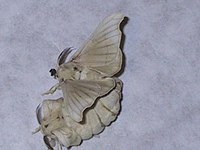
Photo from wikipedia
Ecological investigations of silkworms have revealed that Eri silkworms (Samia cynthia ricini) possess useful morphological and ecological characteristics for virus-like particle (VLP) production, namely non-seasonal breeding, longer lengths, and heavier… Click to show full abstract
Ecological investigations of silkworms have revealed that Eri silkworms (Samia cynthia ricini) possess useful morphological and ecological characteristics for virus-like particle (VLP) production, namely non-seasonal breeding, longer lengths, and heavier weights than Bombyx mori silkworms. Furthermore, when vector DNA from Bombyx mori nuclear polyhedrosis virus (BmNPV), which is unable to replicate in Sf9 cells from Eri silkworms, was replaced with the Autographa californica nuclear polyhedrosis virus (AcNPV) vector, three improved AcNPV influenza virus recombinants capable of replication in Sf9 cells were obtained. Although VLP antigens produced previously in silkworms were not evaluated individually, the present recombinant Fukushima (FkH5) and Anhui (AnH7) VLP antigens were detected in tissue fluids and fat bodies of Eri silkworms. Here, we aimed to determine the function of the AcNPV vector and P143 gene by expressing recombinants in Sf9 cells and eri silkworm pupae. The FkH5 recombinant produced high yields of haemagglutinin (HA)-positive VLPs, showing a mean HA titre of 1.2 million. Similarly, high production of H7 HA VLPs was observed in the fat bodies of eri silkworm pupae. Antigenic analysis and electron microscopy examination of Eri-silkworm-produced H5 HA VLPs showed characteristic antigenicity and morphology similar to those of the influenza virus. Although FkH5 recombinants possessing the AcNPV vector did not replicate in Bm-N cells, the introduction of the helicase p143 gene from BmNPV resulted in their production in Bm-N and Sf9 cells.
Journal Title: Archives of Virology
Year Published: 2018
Link to full text (if available)
Share on Social Media: Sign Up to like & get
recommendations!